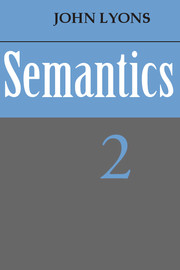Book contents
- Frontmatter
- Contents
- Figures
- Typographical conventions
- Preface
- 10 Semantics and grammar I
- 11 Semantics and grammar II
- 12 Semantics and grammar III
- 13 The Lexicon
- 14 Context, style and culture
- 15 Deixis, space and time
- 16 Mood and illocutionary force
- 17 Modality
- Bibliography
- Index of subjects
- Index of personal names
17 - Modality
Published online by Cambridge University Press: 05 June 2012
- Frontmatter
- Contents
- Figures
- Typographical conventions
- Preface
- 10 Semantics and grammar I
- 11 Semantics and grammar II
- 12 Semantics and grammar III
- 13 The Lexicon
- 14 Context, style and culture
- 15 Deixis, space and time
- 16 Mood and illocutionary force
- 17 Modality
- Bibliography
- Index of subjects
- Index of personal names
Summary
Necessity and possibility
As we saw in a previous chapter, logicians generally draw a distinction between propositions that are contingently true or false, synthetic propositions, and propositions that are either necessarily true, analytic propositions or tautologies, or necessarily false, contradictions (cf. 6.5). To say that a proposition is contingently true is to imply that, although it is in fact true of the world, or of the state of the world, that is being described, there are other possible worlds, or states of the world, of which it is, or might be, false. A necessarily true, or analytic, proposition, on the other hand, is one whose truth is not simply a matter of the way the world happens to be at some particular time. Analytic propositions, as Leibniz put it, are true in all possible worlds. Their truth is established, or guaranteed, by the meaning of the sentences which express them; and our knowledge, or belief, that they are true is non-empirical, in the sense that it is not grounded in, and cannot be modified by, experience.
Necessity and possibility are the central notions of traditional modal logic; and they are related, like universal and existential quantification (cf. 6.3), in terms of negation. If p is necessarily true, then its negation, ∼p, cannot possibly be true; and if p is possibly true, then its negation is not necessarily true.
- Type
- Chapter
- Information
- Semantics , pp. 787 - 849Publisher: Cambridge University PressPrint publication year: 1977
- 2
- Cited by



